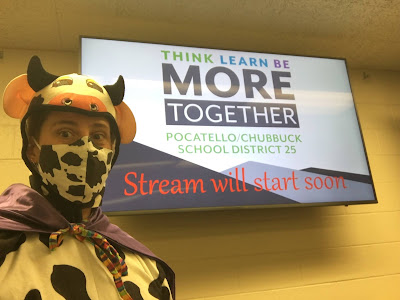Appeared in the Idaho State Journal on December 27, 2020.
Earlier during the pandemic, my wife told me I should quit asking people how they are because it forces them to lie. No one is doing “well” or “fine” these days. With regard to answering the question, she’s probably right about people who are polite, private and introverted like she is. People like me, however, who are boundary-challenged and blurt out overshares have no problem answering honestly.
Depending on the time of day, you’ll get a different answer from me as to how I am doing. At the time of this writing for instance? I’m good. Great in fact. I’ve been going through all of our digital photographs from the year to make photo collages for our 12 and 15 year old boys as New Year’s gifts. (They’re unlikely to read this, but shhhhh. Please don’t spoil the surprise.) The smiles in our pictures present the bits of joy we experienced in 2020, and I’ve been sitting here reliving it.
Before the March shutdowns, I worked from home often. The nature of my job has me running software at all hours of the day. I will often work while we watch movies in the evenings, kick things off to run overnight, and analyze results first thing in the morning over a cup of coffee. On March 16, however, I checked out a monitor, my custom green office chair and a plastic chair mat to set up a semi-permanent office area in my basement. With a 6-foot Costco table next to a space heater and the cat gym, I was prepared to work from home as long as needed.
When the work force trickled back into office settings in June, I was still doing my morning and evening work tasks at home but returned to the facility fulltime. I have my own hard-walled office where I’m able to work mask-free, and when I need to collaborate with colleagues or walk through common areas, I mask up and carry on as “normal.” As far as the pandemic has gone, I’ve felt extreme gratitude swirled with a touch of guilt at how fortunate I am to not only have kept working, but to be working in environments that are low risk for COVID-19.
My wife, however, works in the lab at a hospital. She has a seven-on/seven-off shift that’s aligned to have her working both Thanksgiving and Christmas in 2020. She's one of the few who run their COVID-19 tests, so her paws are in it daily. She wears an N95 for her ten-hour shift, and when she’s worn one out and gets a new one, the out-of-the-box elasticity leaves grooves, almost cuts, on her face. There are extra shields, hoods and precautions when she's working with live samples, but she’s got a relentless shroud of unease that she will bring the virus home to her kids or her asthmatic and now-out-of-shape wife. I can see the heavy effects of her job first hand while she sees the even heavier effects on the doctors, nurses and other healthcare workers alongside her.
It’s no wonder she suggested I quit asking people how they are doing. Not only do we have strikingly different personalities, our professional pandemic experiences have been poles apart. Following her advice, I did stop asking my friends and acquaintances how they were doing. The older I get, the more I realize that striving to treat others as I would like to be treated isn’t always the best route. Sure, it’s a good guide, but with our innate differences, to be a good friend, partner and even citizen, I’m getting better at seeking to treat others how they would like to be treated, aside from what I might prefer.
My wife got her first shot of the COVID-19 vaccine last week. The picture she sent immediately following shows her sleeve raised with a Band-Aid at the shot site and, although her mask covers much of her face, I can see the brightest smiling eyes of 2020. That picture is going right in the center of the boys’ photo medley.
This gift for the kids is meant to highlight the rainbows among the rain in 2020, and it has been marvelously therapeutic for me. Even when I thought we were not doing well or fine, I can see that we were doing okay. I often want to fix things and solve all the problems, but this past year I couldn’t. I’ve had to learn that listening can be as important as fixing, and with that I am going to go back to asking people how they are. If people feel moved to give me a lying “fine”, that’s okay, but as I’ve seen our 2020 replayed in these photographs, I’ve got a renewed energy to ask and listen. How are you?

